child seat GMC YUKON DENALI 2003 Owners Manual
[x] Cancel search | Manufacturer: GMC, Model Year: 2003, Model line: YUKON DENALI, Model: GMC YUKON DENALI 2003Pages: 447, PDF Size: 21.97 MB
Page 2 of 447

The 2003 GMC Yukon DenaIiNukon XL Denali
Owner Manual
Seats and Restraint Systems ........................... 1-1
Front Seats
............................................... 1-3
Rear Seats
............................................... 1-7
Safety Belts
............................................. 1-25
Child Restraints
....................................... 1-48
Air Bag Systems
...................................... 1-72
Restraint System Check
............................ 1-86
Features and Controls ..................................... 2-1
Keys
........................................................ 2-3
Doors and Locks
....................................... 2-8
Windows
................................................. 2-14
Theft-Deterrent Systems
............................ 2-1 6
Starting and Operating Your Vehicle
....... 2-18
Mirrors
.................................................... 2-31
Onstar@
S stem ...................................... 2-36
HomeLink
J Transmitter ............................. 2-38
Storage Areas
......................................... 2-42
Sunroof
.................................................. 2-46
Vehicle Personalization
............................. 2-47
Instrument Panel ............................................. 3-1
Instrument Panel Overview
.......................... 3-4
Warning Lights, Gages and Indicators
......... 3-28
Driver Information Center (DIC)
.................. 3-43
Climate Controls
...................................... 3-1 9
Audio System(s)
....................................... 3-58
Driving Your Vehicle ....................................... 4-1
Your Driving, the Road, and Your Vehicle
..... 4-2
Towing
................................................... 4-44
Service
..................................................... 5-3
Fuel
......................................................... 5-5
Checking Things Under the Hood ............... 5-10
All-Wheel Drive
........................................ 5-46
Rear Axle ............................................... 5-48
Bulb Replacement
.................................... 5-49
Tires
...................................................... 5-55
Appearance Care ..................................... 5-78
Vehicle Identification
................................. 5-86
Electrical System
...................................... 5-87
Capacities and Specifications
..................... 5-96
Normal Maintenance Replacement Parts
...... 5-98
Maintenance Schedule
................................ 6-2
Customer Assistance Information .................... 7-1
Customer Assistance Information
.................. 7-2
Reporting Safety Defects
............................ 7-9
Index ................................................................ 1
Service and Appearance Care .......................... 5-1
Windshield Wiper Blade Replacement
......... 5-54
Maintenance Schedule ..................................... 6-1
Page 6 of 447
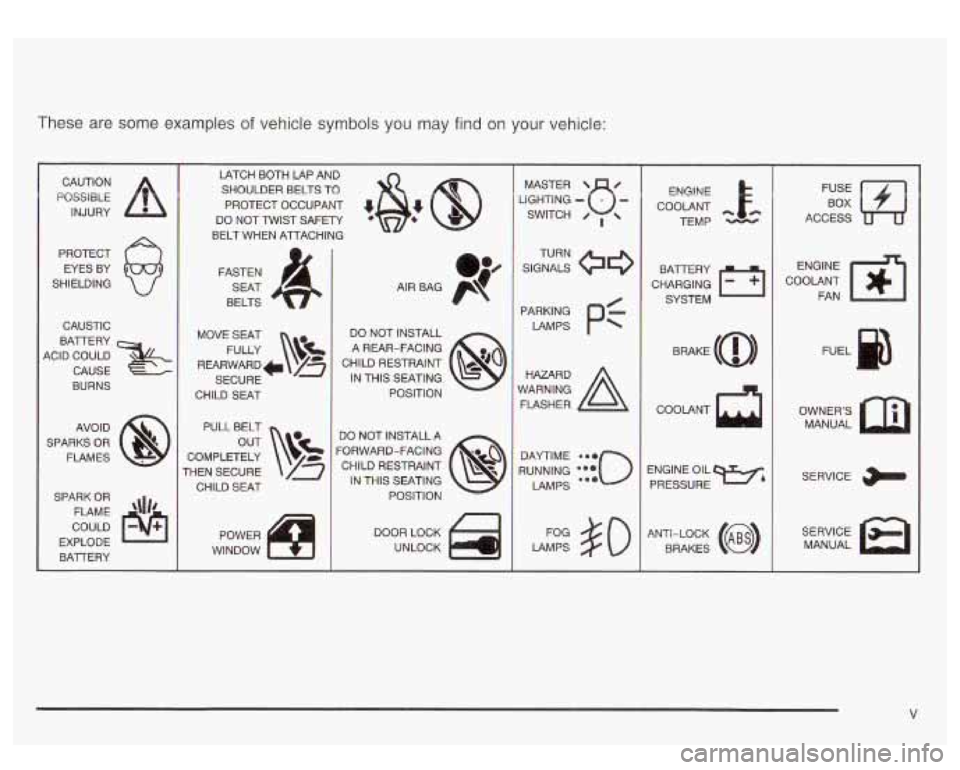
These are some examples of vehicle symbols you may find on your vehicle:
CAUTION
POSSIBLE
INJURY
PROTECT EYES BY
SHIELDING
CAUSTIC
BATTERY
ACID COULD CAUSE
BURNS
AVO ID
SPARKS
OR
FLAMES
SPARK
OR
FLAME '\I/'
COULD
EXPLODE BATTERY LATCH BOTH LAP AND
SHOULDER BELTS TO
PROTECT OCCUPANT
4
DO NOT TWIST SAFETY
BELT WHEN ATTACHING
FASTEN SEAT
BELTS
MOVE SEAT DO NOT INSTALL
A REAR-FACING
CHILD RESTRAINT
SECURE IN THIS SEATING
CHILD SEAT POSITION
FULLY
c REARWARD+ /3
PULL BELT DO NOT INSTALL A
COMPLETELY
THEN SECURE
CHILD SEAT FORWARD-FACING
CHILD RESTRAINT IN THIS SEATING
POSITION
POWER DOOR LOCK
WINDOW UNLOCK LIGHTING
- MASTER SWITCH u- 0 ,
LAMPS #O
ENGINE
COOLANT
-FA TEMP -
CHARGING Fl
BATTERY
SYSTEM
ENGINE OIL PRESSURE
9%77
ANTI-LOCK (@)
BRAKES
FUSE BOX
ACCESS
ENGINE
COOLANT FAN
OWNER'S MANUAL
SERVICE
SERVICE MANUAL
V
Page 8 of 447
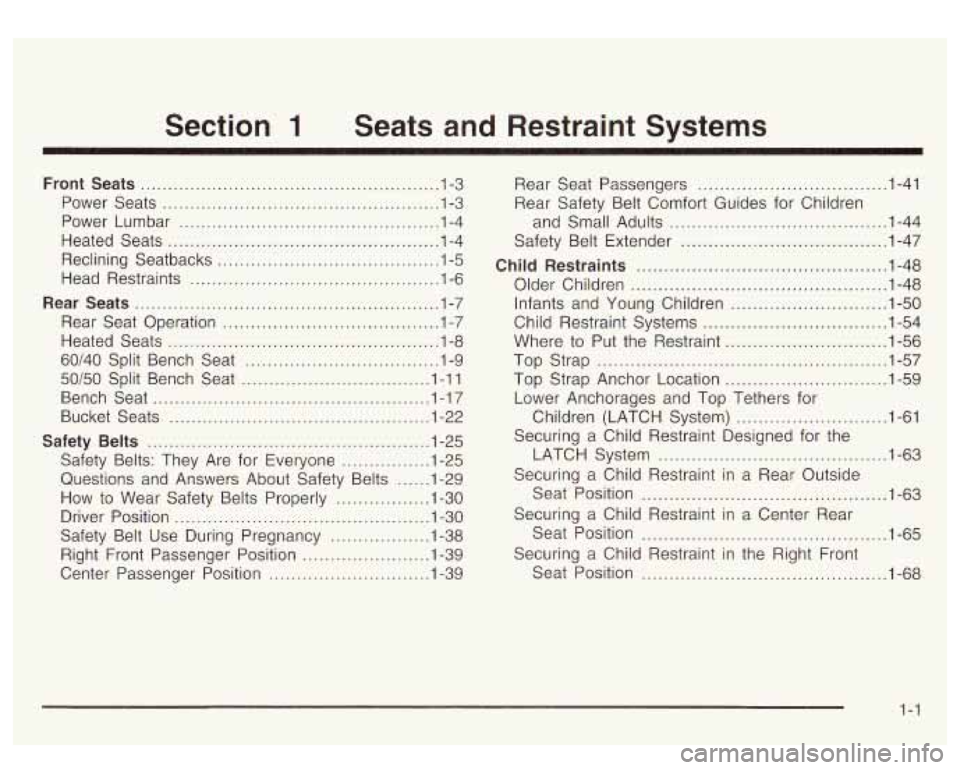
1 Seats and Restraint Systems
Front Seats ...................................................... 1.3
Power Seats
...... ..................................... 1-3
Power Lumbar
............................................... 1-4
Heated Seats
................................................. 1.4
Reclining Seatbacks
........................................ 1.5
Head Restraints
............................................. 1-6
Rear Seats .................................................. .l -7
Rear Seat Operation .. ...... 1-7
Heated Seats
................................................. 1-8
60/40 Split Bench Seat
................................... 1-9
50/50 Split Bench Seat .................................. 1-1 1
Bench Seat
.............................................. 1.1 7
Bucket Seats ........................................... 1-22
Safety Belts ................................................... 1-25
Safety Belts: They Are for Everyone
................ 1-25
Questions and Answers About Safety Belts
...... 1.29
How
to Wear Safety Belts Properly ................. 1-30
Driver Position
.............................................. 1.30
Safety Belt Use During Pregnancy
.................. 1-38
Right Front Passenger Position
.. ., .... .... 1-39
Center Passenger Position
...... , 1 -39 Rear
Seat Passengers
.................................. 1-41
Rear Safety Belt Comfort Guides for Children and Small Adults
....................................... 1-44
Safety Belt Extender
..................................... 1-47
Child Restraints ............................................. 1-48
Older Children
.............................................. 1.48
Infants and Young Children
....... .......... 1.50
Child Restraint Systems ........ ...... 1-54
Where
to Put the Restraint ............................. 1-56
Top Strap
.................................................... 1.57
Top Strap Anchor Location
............................. 1-59
Lower Anchorages and Top Tethers for
Children (LATCH System)
........................... 1.61
Securing a Child Restraint Designed for the
LATCH System
......................................... 1-63
Securing a Child Restraint in a Rear Outside
Seat Position
............................................ 1-63
Securing
a Child Restraint in a Center Rear
Seat Position
............................................ 1.65
Securing a Child Restraint in the Right Front
Seat Position
......................... .I -68
1-1
Page 46 of 447
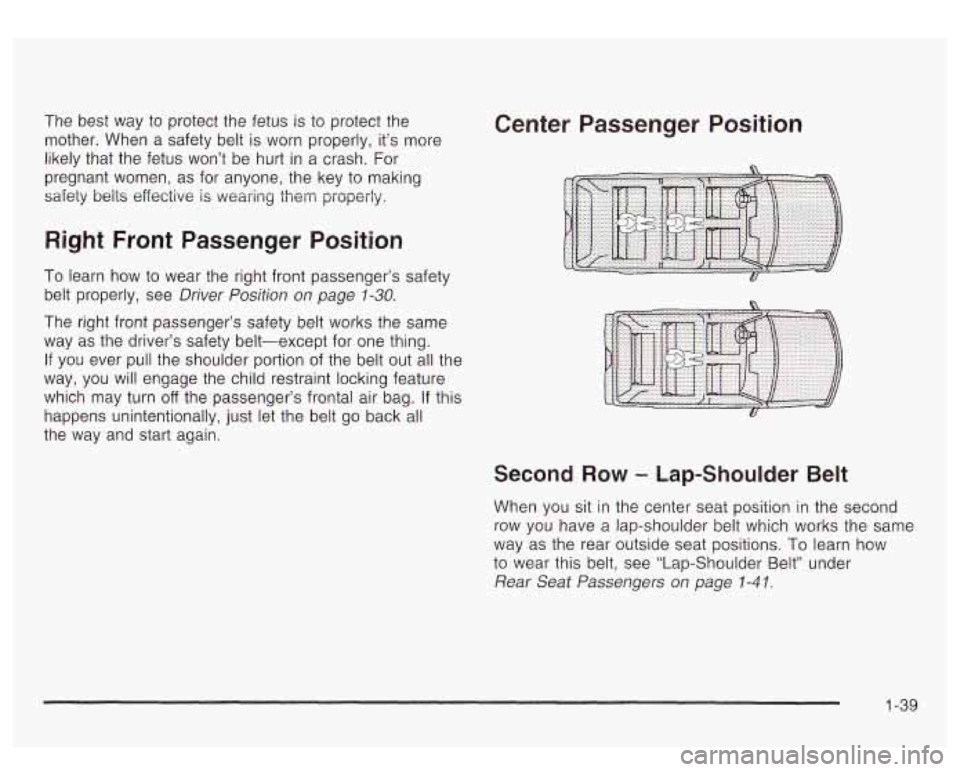
The best way to protect the fetus is to protect the
mother. When a safety belt is worn properly, it’s more
likely that the fetus won’t be hurt in a crash. For
pregnant women, as for anyone, the key to making
safety belts effective is Wearing them properly.
Right Front Passenger Position
To learn how to wear the right front passenger’s safety
belt properly, see Driver Position on page
1-30,
The right front passenger’s safety belt works the same
way
as the driver’s safety belt-except for one thing.
If you ever pull the shoulder portion of the belt out all the
way, you will engage the child restraint locking feature
which may turn
off the passenger’s frontal air bag. If this
happens unintentionally, just let the belt go back all
the way and start again.
Center Passenger Position
Second Row - Lap-Shoulder Belt
When you sit in the center seat position in the second
row you have a lap-shoulder belt which works the same
way as the rear outside seat positions. To learn how
to wear this belt, see “Lap-Shoulder Belt” under
Rear Seat Passengers on page
1-4 1.
1-39
Page 51 of 447
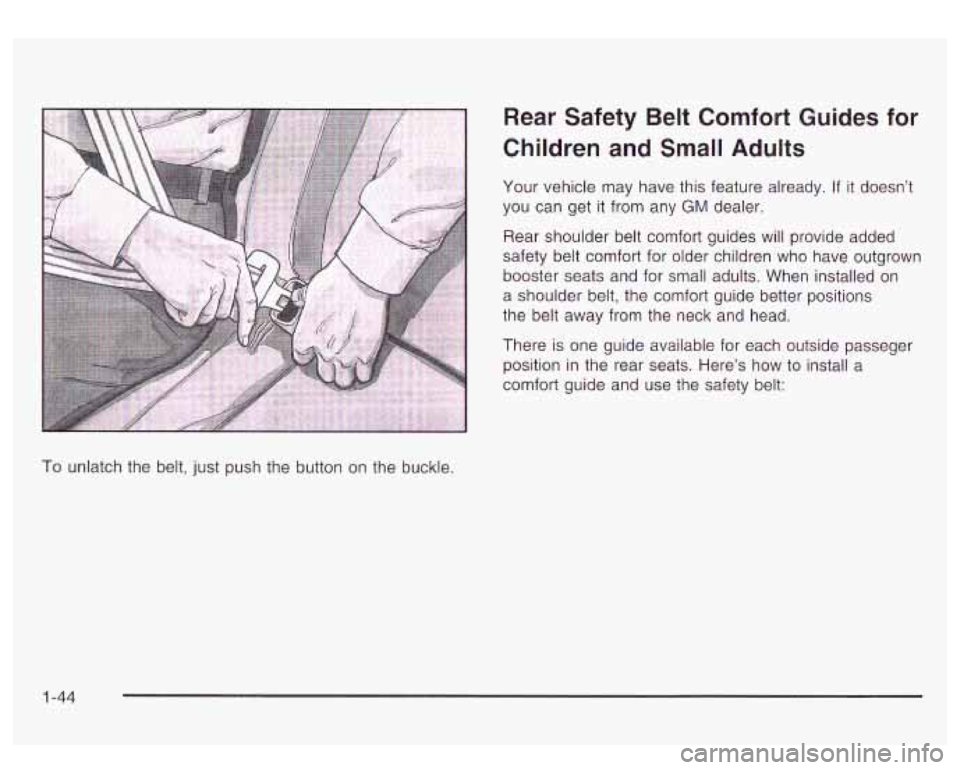
Rear Safety Belt Comfort Guides for
Children and Small Adults
Your vehicle may have this feature already. If it doesn’t
you can get it from any
GM dealer.
Rear shoulder belt comfort guides will provide added
safety belt comfort for older children who have outgrown
booster seats and for small adults. When installed on
a shoulder belt, the comfort guide better positions
the belt away from the neck and head.
There
is one guide available for each outside passeger
position in the rear seats. Here’s how
to install a
comfort guide and use the safety belt:
To unlatch the belt, just push the button on the buckle.
1 -44
Page 55 of 447
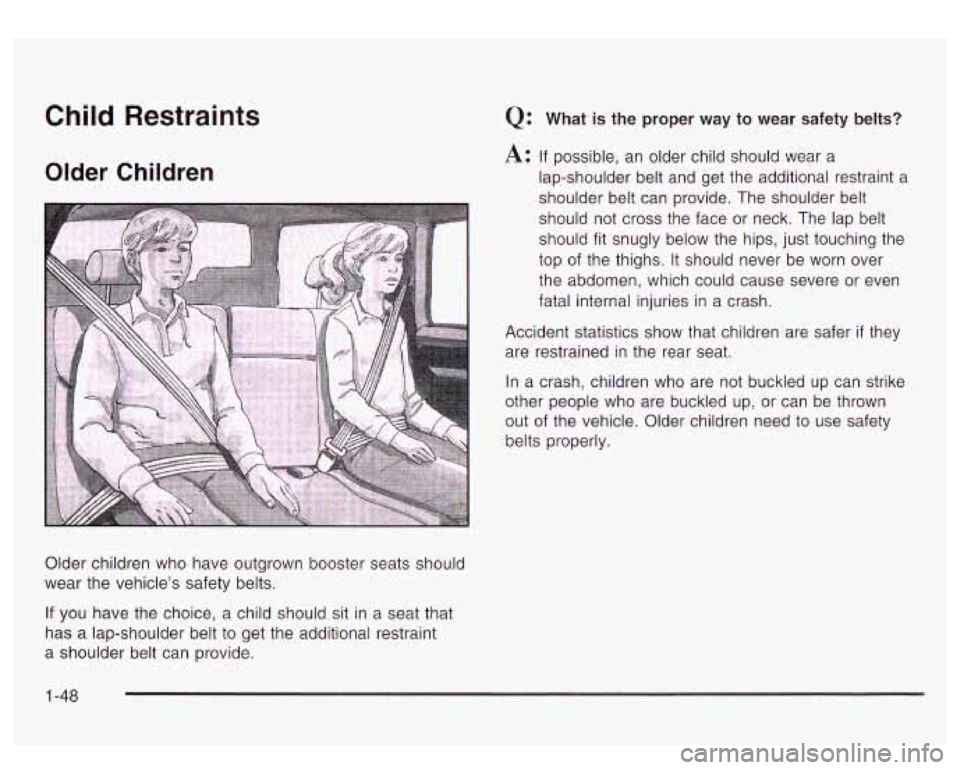
Child Restraints
Older Children
Older children who have outgrown booster seats should
wear the vehicle’s safety belts.
Q: What is the proper way to wear safety belts?
A: If possible, an older child should wear a
lap-shoulder belt and get the additional restraint a
shoulder belt can provide. The shoulder belt
should not cross the face or neck. The lap belt
should fit snugly below the hips, just touching the
top
of the thighs. It should never be worn over
the abdomen, which could cause severe or even
fatal internal injuries in a crash.
Accident statistics show that children are safer
if they
are restrained in the rear seat.
In a crash, children who are not buckled up can strike
other people who are buckled up, or can be thrown
out of the vehicle. Older children need to use safety
belts properly.
If you have the choice, a child should sit in a seat that
has
a lap-shoulder belt to get the additional restraint
a shoulder belt can provide.
1-48
Page 56 of 447

Never do this.
Here two children are wearing the same belt.
The belt can’t properly spread the impact forces.
In a crash, the two children can be
crushed together and seriously injured.
A belt
must be used by only one person at a time.
Q: What if a child is wearing a lap-shoulder belt,
but the child
is so small that the shoulder belt
is very close to the child’s face or neck?
A: If the child is sitting in a rear seat outside position,
move the child toward the center
of the vehicle.
See Rear Safety Belt Comfort Guides for Children
and Small Adults
on page 1-44. If the child is
sitting in the center position, move the child toward
the safety belt buckle. In either case, be sure
that the shoulder belt still
is on the child’s shoulder,
so that in a crash the child’s upper body would
have the restraint that belts provide.
1-49
Page 57 of 447

If the child is so small that the shoulder belt is still
very close to the child’s face or neck, you might
want
to place the child in a seat that has a lap belt,
if your vehicle has one.
Never
do this.
Here
a child is sitting in a seat that has a
lap-shoulder belt, but the shoulder part is
behind the child. If the child wears the belt in
this way, in
a crash the child might slide under
the belt. The belt’s force would then be applied
right on the child’s abdomen. That could cause
serious or fatal injuries.
Wherever the child sits, the lap portion of the belt
should be worn
low and snug on the hips, just touching
the child’s thighs. This applies belt force
to the child’s
pelvic bones in a crash.
Infants and Young Children
Everyone in a vehicle needs protection! This includes
infants and all other children. Neither the distance
traveled nor the age and size of the traveler changes
the need, for everyone, to use safety restraints. In fact,
the law in every state in the United States and in
every Canadian province says children up to some age
must be restrained while in a vehicle.
1-50
Page 60 of 447

For most basic types of child restraints, there are
many different models available. When purchasing a
child restraint, be sure it is designed
to be used
in a motor vehicle. If it is, the restraint will have a
label saying that it meets federal motor vehicle
safety standards.
The restraint manufacturer’s instructions that come
with the restraint state the weight and height
limitations for a particular child restraint. In addition,
there are many kinds of restraints available for
children with special needs.
Newbc.
__ infants need complete support,
including support for the head and neck. This
is necessary because a newborn infant’s neck
is weak and its head weighs
so much
compared with the rest of its body.
In a crash,
an infant in a rear-facing seat settles into the
restraint,
so the crash forces can be
distributed across the strongest part of an
infant’s body, the back and shoulders. Infants
always should be secured in appropriate infant restraints. The body structure of a young child
is quite
unlike that of an adult or older child, for whom
the safety belts are designed.
A young child’s
hip bones are still
so small that the vehicle’s
regular safety belt may not remain low on the
hip bones, as
it should. Instead, it may settle
up around the child’s abdomen.
In a crash, the
belt would apply force on a body area that’s
unprotected by any bony structure. This alone
could cause serious or fatal injuries. Young
children always should be secured in
appropriate child restraints.
1-53
Page 61 of 447
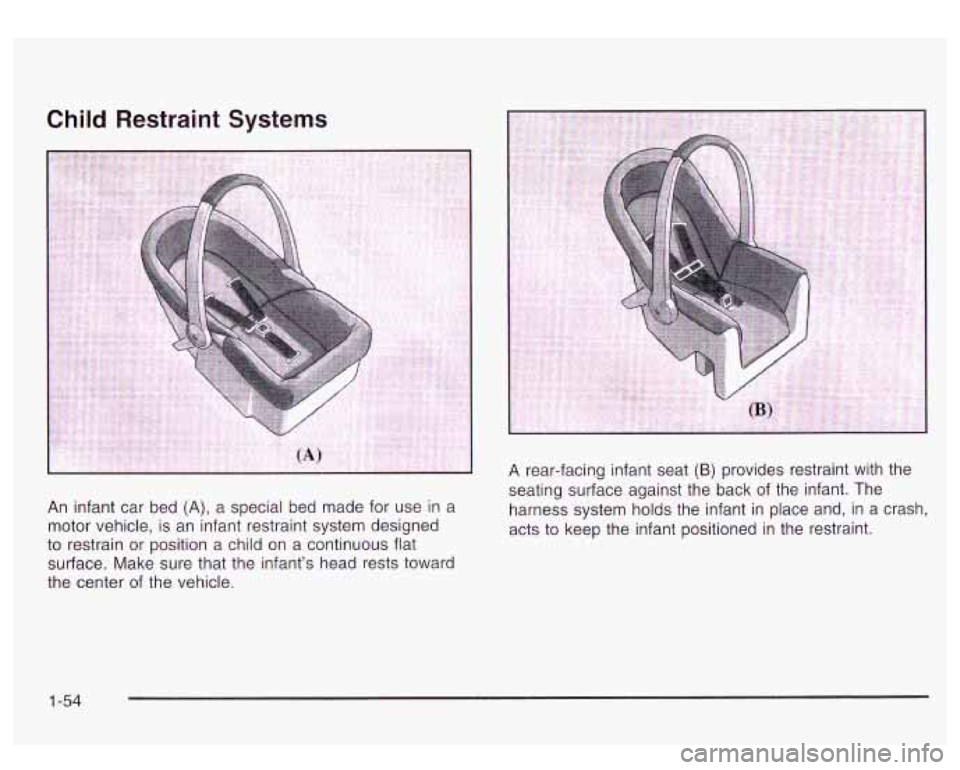
Child Restraint Systems
. ..
seating surface against the back of the infant. The
An infant car bed
(A), a special bed made for use in a harness system holds the infant in place and, in a crash,
motor vehicle, is an infant restraint system designed acts to keep the infant positioned in the restraint.
to restrain or position a child on a continuous flat
surface. Make sure that the infant’s head rests toward
the center of the vehicle.
1-54